Your cart is currently empty!
Tag: language
-
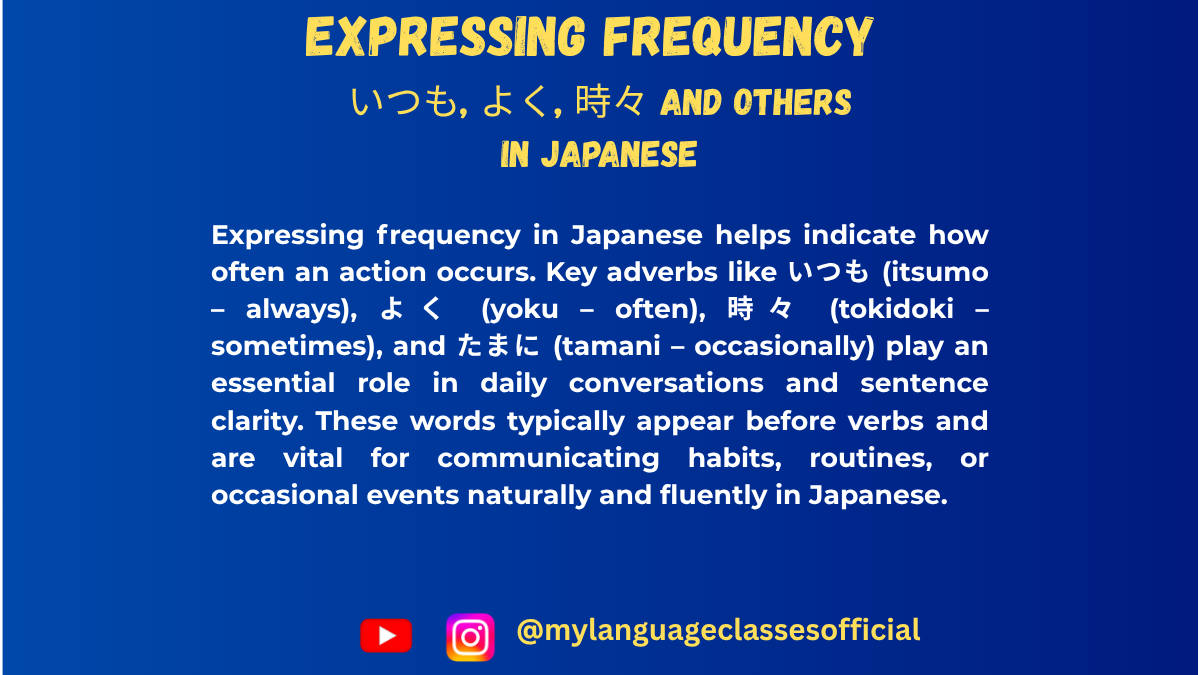
Expressing Frequency in Japanese | My Language Classes
How to Talk About Frequency in Japanese
Learning how to express frequency is an essential part of mastering any language. In Japanese, there are various ways to indicate how often something happens, ranging from daily habits to rare occurrences. This guide will provide all the patterns and tips you need to express frequency like a native speaker.
Basic Frequency Vocabulary
Here are some common adverbs used to express frequency in Japanese:
Japanese Romaji English Translation Example Sentence いつも itsumo always 私はいつも朝ごはんを食べます。
(Watashi wa itsumo asagohan o tabemasu.)
I always eat breakfast.よく yoku often 彼はよく映画を見ます。
(Kare wa yoku eiga o mimasu.)
He often watches movies.時々 tokidoki sometimes 私は時々本を読みます。
(Watashi wa tokidoki hon o yomimasu.)
I sometimes read books.たまに tamani occasionally たまに外食します。
(Tamani gaishoku shimasu.)
I occasionally eat out.あまり amari not often (with negation) 私はあまりテレビを見ません。
(Watashi wa amari terebi o mimasen.)
I don’t watch TV often.全然 zenzen never (with negation) 彼女は全然運動しません。
(Kanojo wa zenzen undou shimasen.)
She never exercises.
Patterns for Expressing Frequency
- Using Adverbs
Frequency adverbs are usually placed before the verb they modify.- Example: 私はよくカフェに行きます。
(Watashi wa yoku kafe ni ikimasu.)
I often go to cafes.
- Example: 私はよくカフェに行きます。
- Time Expressions with Frequency Indicators
To specify how often something happens, combine time expressions with frequency words like 回 (kai, “times”) or 度 (do, “times”).- Pattern:
- Time + に (ni) + Number + 回 (kai)
- Example: 一週間に三回ジムに行きます。
(Isshuukan ni sankai jimu ni ikimasu.)
I go to the gym three times a week.
- Pattern:
- Using 毎 (mai) for Recurring Activities
The prefix 毎 (mai) means “every” and is used to indicate regularity.- Examples:
- 毎日 (mainichi) – every day
- 毎週 (maishuu) – every week
- 毎月 (maigetsu/maitsuki) – every month
- 毎年 (mainen/maitoshi) – every year
- Example Sentence: 私は毎朝ジョギングをします。
(Watashi wa maiasa jogingu o shimasu.)
I jog every morning.
- Examples:
- Using ~ごとに (~goto ni)
This suffix indicates regular intervals.- Example: 二日ごとに掃除します。
(Futsuka goto ni souji shimasu.)
I clean every two days.
- Example: 二日ごとに掃除します。
- Expressing Negative Frequency
When using words like あまり (amari) or 全然 (zenzen), they must be paired with a verb in the negative form.- Examples:
- 彼はあまり勉強しません。
(Kare wa amari benkyou shimasen.)
He doesn’t study much. - 私は全然泳ぎません。
(Watashi wa zenzen oyogimasen.)
I never swim.
- 彼はあまり勉強しません。
- Examples:
Things to Keep in Mind
- Context Matters
- The frequency you use depends on the situation. For instance, using “always” (いつも) too often might make you sound exaggerated or unnatural in casual speech.
- Cultural Nuances
- Japanese people often use frequency expressions to politely imply how often they perform an action, even if it’s not true all the time. For instance, saying “よくやります” (I often do it) can sometimes serve as a polite expression rather than an exact frequency.
- Differentiating 回 (kai) and 度 (do)
- 回 (kai) is more common in casual speech, while 度 (do) can feel more formal or traditional.
- Practice Pronunciation
- Properly enunciate frequency adverbs for clarity. For instance, たまに (tamani) and 時々 (tokidoki) should not be rushed when speaking.
Practical Exercises
- Fill in the blanks with the correct frequency adverb:
- 私は(____)カラオケに行きます。
- Hint: If you go “sometimes,” use 時々.
- Translate the sentences into Japanese:
- I clean my room every week.
- He rarely eats sushi.
- Create Your Own Sentences:
- Write three sentences using different frequency adverbs. Share them with a friend or teacher for feedback!
By mastering these expressions and patterns, you’ll be well on your way to sounding natural and fluent in Japanese. Remember, practice makes perfect—so use these structures in your daily conversations and writing!
Have questions or need more practice examples? Let me know in the comments below!
If you enjoyed this lesson, be sure to check out more posts like this on my blog at My Language Classes. Don’t forget to subscribe my YouTube channel and follow me on Instagram for the latest language learning tips and lessons. Leave a comment below to share your thoughts, or ask any questions you have about nouns.
Happy learning! 😊
- Using Adverbs
-
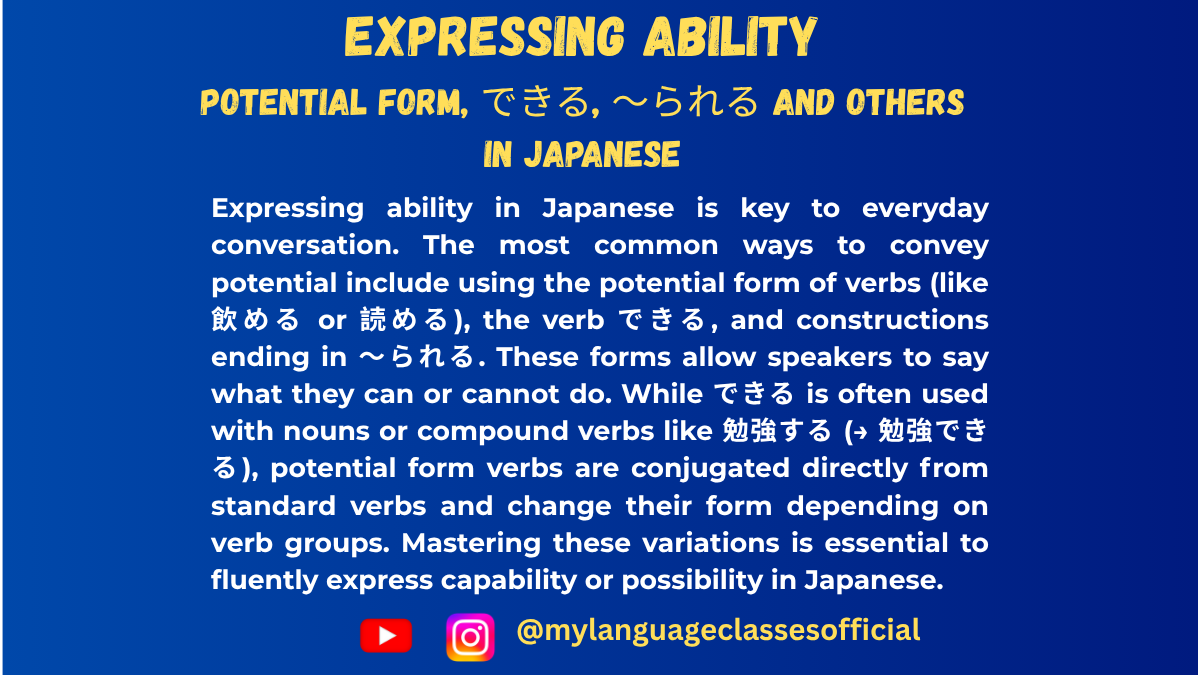
Expressing Ability in Japanese | My Language Classes
How to Express Ability in Japanese
When learning Japanese, expressing ability is an essential skill. Japanese uses specific grammatical structures to indicate whether you can do something. These expressions differ depending on the type of verb, politeness level, and context. This blog post will cover all the patterns and nuances you need to know.
1. Using Potential Form (可能形, Kanoukei)
The potential form of verbs is the most common way to express ability in Japanese. This form modifies the verb to mean “can” or “be able to.”
Formation Rules:
- Group 1 Verbs (五段動詞): Change the last “u” sound to its corresponding “e” sound and add -る.
- 書く (kaku, to write) → 書ける (kakeru, can write)
- 飲む (nomu, to drink) → 飲める (nomeru, can drink)
- Group 2 Verbs (一段動詞): Simply replace -る with -られる.
- 食べる (taberu, to eat) → 食べられる (taberareru, can eat)
- Irregular Verbs:
- する (suru, to do) → できる (dekiru, can do)
- 来る (kuru, to come) → 来られる (korareru, can come)
Usage in Sentences:
- ピアノを弾けますか? (Piano o hikemasu ka?)
Can you play the piano? - 日本語が話せます。 (Nihongo ga hanasemasu.)
I can speak Japanese.
Note: For Group 2 verbs, the shortened form 食べれる is often used in casual speech, but it may be considered grammatically incorrect in formal contexts.
2. Using the Verb できる (Dekiru)
できる is a versatile verb that expresses general ability or possibility. It is often used with nouns or “nominalized verbs” (verbs turned into nouns).
Formation Rules:
- [Noun] + ができる
- スキーができる (Sukī ga dekiru) → I can ski.
- [Verb in dictionary form] + ことができる
- 本を読むことができる (Hon o yomu koto ga dekiru) → I can read books.
Usage in Sentences:
- 私は泳ぐことができません。 (Watashi wa oyogu koto ga dekimasen.)
I cannot swim. - 新しいゲームができる。 (Atarashii geemu ga dekiru.)
I can play a new game.
Tip: Use できる for broader abilities or formal contexts, while the potential form of verbs is more direct.
3. Expressing Inability with できない and Potential Form
The negative forms of できる and potential verbs are used to express inability.
- 書けない (kakenai, cannot write)
- 飲めない (nomenai, cannot drink)
- できない (dekinai, cannot do)
Examples:
- 車を運転できません。 (Kuruma o unten dekimasen.)
I cannot drive a car. - 漢字が読めない。 (Kanji ga yomenai.)
I cannot read kanji.
4. Using Expressions with 〜られる in Daily Conversation
In casual conversation, 〜られる forms often sound softer and less assertive. You can use them to express possibilities or abilities politely.
Examples:
- この本、読めますか? (Kono hon, yomemasu ka?)
Can you read this book? - 外国語は難しいけど、頑張れば話せるよ! (Gaikokugo wa muzukashii kedo, ganbareba hanaseru yo!)
Foreign languages are hard, but you can speak them if you try!
5. Using ~ことがある to Talk About Situational Ability
You can also use ~ことがある to describe situations where something is possible or permissible.
Examples:
- 会議室を使うことができますか? (Kaigishitsu o tsukau koto ga dekimasu ka?)
Is it possible to use the meeting room? - この公園で遊ぶことができます。 (Kono kōen de asobu koto ga dekimasu.)
You can play in this park.
6. Things to Keep in Mind
- Politeness Levels:
Adjust the verb endings according to the situation. For example:- Polite: 話せます (hanasemasu)
- Casual: 話せる (hanaseru)
- Using が vs. を:
When expressing ability, the object marker changes from を to が:- ピアノを弾く → ピアノが弾ける
- Cultural Sensitivity:
Japanese speakers often avoid being overly assertive about their abilities. Phrases like ちょっと難しいです (chotto muzukashii desu, “It’s a bit difficult”) can soften the tone.
7. Practice Sentences for Learners
- 明日、山に登れますか? (Ashita, yama ni noboremasu ka?)
Can you climb the mountain tomorrow? - 子どもの時、泳ぐことができました。 (Kodomo no toki, oyogu koto ga dekimashita.)
When I was a child, I could swim. - 日本語でメールを書けますか? (Nihongo de mēru o kakemasu ka?)
Can you write an email in Japanese?
Expressing ability in Japanese can feel tricky at first, but with practice, it becomes natural. Master these forms, and you’ll be able to communicate your skills and understand others effortlessly!
Have questions or want more examples? Share them in the comments below! 🌸
If you enjoyed this lesson, be sure to check out more posts like this on my blog at My Language Classes. Don’t forget to subscribe my YouTube channel and follow me on Instagram for the latest language learning tips and lessons. Leave a comment below to share your thoughts, or ask any questions you have about nouns.
Happy learning! 😊
- Group 1 Verbs (五段動詞): Change the last “u” sound to its corresponding “e” sound and add -る.
-

Mastering Degree Words in Japanese | My Language Classes
Mastering Degree Expressions in Japanese
Degree expressions in Japanese are essential tools for describing intensity, extent, or degree of an action or quality. They are commonly used in daily conversation and writing, adding nuance and specificity to your expressions. This blog post explores patterns like とても (“very”) and あまり (“not very”) along with other degree expressions, providing details on their usage, nuances, and examples.
1. Basic Degree Expressions
とても (Totemo) – “Very”
- Usage: Used to emphasize a high degree of something.
- Structure:
とても + adjective/adverb
Example:- このケーキはとてもおいしいです。
(Kono kēki wa totemo oishii desu.)
→ This cake is very delicious. - 彼はとても速く走ります。
(Kare wa totemo hayaku hashirimasu.)
→ He runs very fast.
- このケーキはとてもおいしいです。
あまり (Amari) – “Not very” (with negative forms)
- Usage: Indicates a low degree of something and is used with negative forms of verbs or adjectives.
- Structure:
あまり + negative form of adjective/verb
Example:- あの映画はあまりおもしろくなかったです。
(Ano eiga wa amari omoshiroku nakatta desu.)
→ That movie wasn’t very interesting. - 天気はあまり良くありませんでした。
(Tenki wa amari yoku arimasen deshita.)
→ The weather wasn’t very good.
- あの映画はあまりおもしろくなかったです。
2. Other Common Degree Expressions
少し / ちょっと (Sukoshi / Chotto) – “A little”
- Usage: Indicates a small degree or extent. ちょっと is more casual than 少し.
- Structure:
少し/ちょっと + adjective/verb
Example:- 部屋は少し寒いです。
(Heya wa sukoshi samui desu.)
→ The room is a little cold. - ちょっと待ってください。
(Chotto matte kudasai.)
→ Please wait a moment.
- 部屋は少し寒いです。
かなり / 相当 (Kanari / Sōtō) – “Quite/Considerably”
- Usage: Indicates a significant degree, but less than とても.
- Structure:
かなり/相当 + adjective/adverb
Example:- この問題はかなり難しいです。
(Kono mondai wa kanari muzukashii desu.)
→ This problem is quite difficult. - 彼は相当疲れているようです。
(Kare wa sōtō tsukarete iru yō desu.)
→ He seems considerably tired.
- この問題はかなり難しいです。
非常に (Hijō ni) – “Extremely”
- Usage: Formal and strong degree expression, often used in written or formal contexts.
- Structure:
非常に + adjective/adverb
Example:- このテクノロジーは非常に有用です。
(Kono tekunorojī wa hijō ni yūyō desu.)
→ This technology is extremely useful.
- このテクノロジーは非常に有用です。
3. Nuanced Degree Expressions
そんなに (Sonna ni) – “So much” (with negative)
- Usage: Typically used in negative contexts to downplay something.
- Structure:
そんなに + negative form
Example:- この宿題はそんなに難しくありません。
(Kono shukudai wa sonna ni muzukashiku arimasen.)
→ This homework isn’t so difficult.
- この宿題はそんなに難しくありません。
めっちゃ / 超 (Meccha / Chō) – “Super” (Informal)
- Usage: Extremely casual and common in spoken Japanese, especially among younger people.
- Structure:
めっちゃ/超 + adjective
Example:- この店のラーメン、超うまい!
(Kono mise no rāmen, chō umai!)
→ The ramen at this place is super delicious! - 昨日はめっちゃ楽しかった。
(Kinō wa meccha tanoshikatta.)
→ Yesterday was super fun.
- この店のラーメン、超うまい!
4. Expressing Extremes
一番 (Ichiban) – “The most”
- Usage: Indicates the highest degree or rank.
- Structure:
一番 + adjective/adverb
Example:- 富士山は日本で一番高い山です。
(Fujisan wa Nihon de ichiban takai yama desu.)
→ Mount Fuji is the tallest mountain in Japan.
- 富士山は日本で一番高い山です。
最高に (Saikō ni) – “The best/most”
- Usage: Used to express the peak level of a positive quality.
- Structure:
最高に + adjective
Example:- 今日は最高に幸せです。
(Kyō wa saikō ni shiawase desu.)
→ I’m the happiest today.
- 今日は最高に幸せです。
5. Things to Keep in Mind
- Context Matters:
- Use formal expressions like 非常に in professional or academic settings.
- Opt for casual expressions like めっちゃ in informal conversations.
- Politeness Levels:
Adjust your degree expressions depending on who you are speaking to. For instance, avoid めっちゃ with your boss, and use とても or かなり instead. - Avoid Overusing:
Overloading sentences with degree expressions can make your speech sound unnatural. Be selective and intentional. - Negative Nuances:
Expressions like あまり and そんなに are inherently tied to negativity. Ensure you pair them with negative predicates.
6. Practice Makes Perfect
The best way to master degree expressions is through regular practice. Try using these patterns in daily conversation or writing. Listen to native speakers in dramas, anime, or news to observe how these expressions are naturally applied.
By incorporating these degree expressions into your Japanese language practice, you’ll develop a richer and more nuanced ability to communicate, allowing you to better convey your thoughts and feelings. Happy learning!
If you enjoyed this lesson, be sure to check out more posts like this on my blog at My Language Classes. Don’t forget to subscribe my YouTube channel and follow me on Instagram for the latest language learning tips and lessons. Leave a comment below to share your thoughts, or ask any questions you have about nouns.
Happy learning! 😊
-
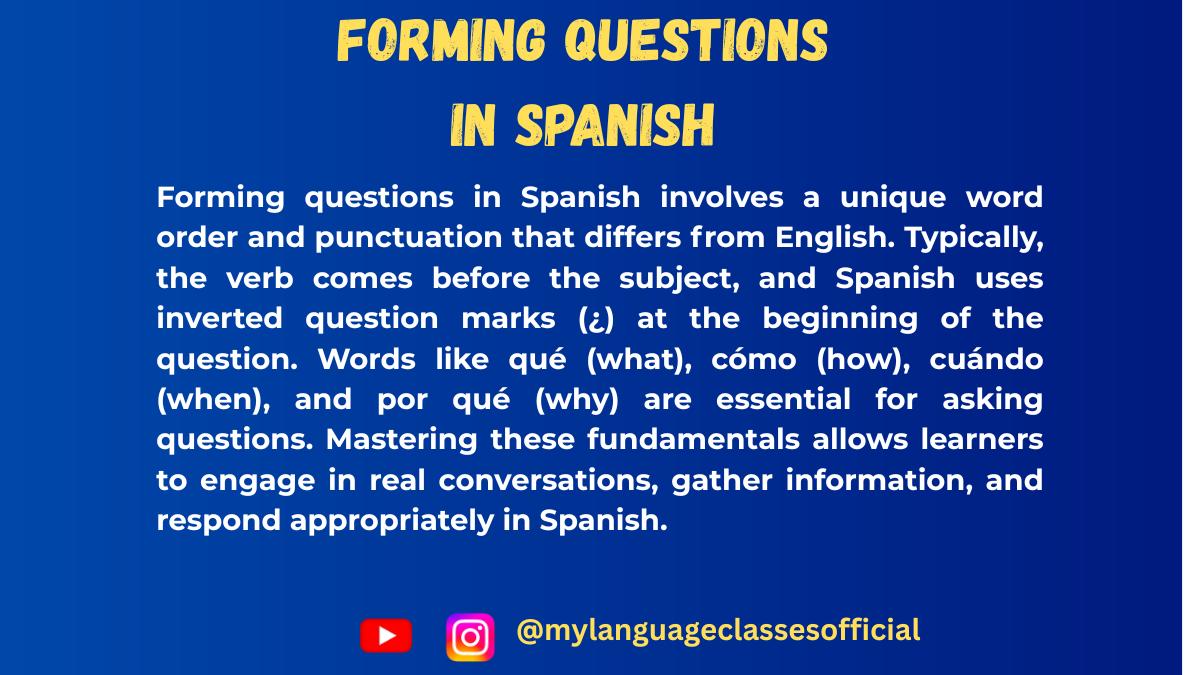
Forming Questions in Spanish
Forming questions in Spanish is essential for effective communication. Whether you’re asking for directions, ordering food, or getting to know someone, mastering this skill will help you express yourself confidently. In this post, we’ll explore the most common question words, how to structure questions, and important grammatical details to keep in mind.
Commonly Used Question Words in Spanish
Here’s a list of essential question words in Spanish, their meanings, and examples of usage:
- ¿Qué? – What?
- Example: ¿Qué quieres comer? (What do you want to eat?)
- ¿Quién? / ¿Quiénes? – Who?
- Example (singular): ¿Quién llamó? (Who called?)
- Example (plural): ¿Quiénes son tus amigos? (Who are your friends?)
- ¿Dónde? – Where?
- Example: ¿Dónde vives? (Where do you live?)
- ¿Cuándo? – When?
- Example: ¿Cuándo es la reunión? (When is the meeting?)
- ¿Por qué? – Why?
- Example: ¿Por qué estudias español? (Why are you studying Spanish?)
- ¿Cómo? – How?
- Example: ¿Cómo estás? (How are you?)
- ¿Cuál? / ¿Cuáles? – Which?
- Example (singular): ¿Cuál es tu color favorito? (Which is your favorite color?)
- Example (plural): ¿Cuáles son tus libros? (Which ones are your books?)
- ¿Cuánto? / ¿Cuánta? / ¿Cuántos? / ¿Cuántas? – How much? / How many?
- Example (masculine singular): ¿Cuánto cuesta? (How much does it cost?)
- Example (feminine singular): ¿Cuánta agua necesitas? (How much water do you need?)
- Example (masculine plural): ¿Cuántos días quedan? (How many days are left?)
- Example (feminine plural): ¿Cuántas personas hay? (How many people are there?)
- ¿Para qué? – What for?
- Example: ¿Para qué sirve esto? (What is this for?)
- ¿De quién? / ¿De quiénes? – Whose?
- Example (singular): ¿De quién es este libro? (Whose book is this?)
- Example (plural): ¿De quiénes son estas mochilas? (Whose backpacks are these?)
Key Grammar Points to Remember
- Inverted Question Marks:
Always start your questions with an inverted question mark (¿) in Spanish.
Example: ¿Cómo te llamas? (What is your name?) - Gender and Number Agreement:
- Question words like cuánto, cuánta, cuántos, and cuántas must agree in gender and number with the noun they refer to.
- Masculine singular: ¿Cuánto dinero tienes? (How much money do you have?)
- Feminine plural: ¿Cuántas flores hay en el jardín? (How many flowers are in the garden?)
- Question words like cuánto, cuánta, cuántos, and cuántas must agree in gender and number with the noun they refer to.
- Verb Placement:
In Spanish, the verb typically follows the question word:- Example: ¿Qué haces? (What are you doing?)
- Articles with Nouns:
When a question involves a noun, the correct article must be used to agree with the gender and number:- Example: ¿Qué opinas del libro? (What do you think about the book?)
- Direct and Indirect Questions:
Direct questions use the question word, while indirect ones introduce the question word within a statement:- Direct: ¿Dónde está la estación? (Where is the station?)
- Indirect: No sé dónde está la estación. (I don’t know where the station is.)
- Intonation in Yes/No Questions:
For yes/no questions, intonation can replace question words.- Statement: Tú vienes mañana. (You are coming tomorrow.)
- Question: ¿Tú vienes mañana? (Are you coming tomorrow?)
Things to Keep in Mind
- Politeness: Use polite structures when needed, like adding por favor (please) or using formal pronouns (usted).
- Example: ¿Podría decirme dónde está el baño? (Could you tell me where the bathroom is?)
- Regional Variations:
Some question structures and vocabulary may vary between Spanish-speaking countries. For instance:- Spain: ¿Cómo te llamas? (What is your name?)
- Mexico: ¿Cuál es tu nombre? (What is your name?)
- Practice Contextual Use:
Try forming questions based on real-life situations, such as asking for directions:- ¿Dónde está el mercado? (Where is the market?)
Practice Exercise
Translate these English questions into Spanish:
- What time is it?
- Where are you from?
- Who is coming to the party?
- How much does it cost?
- Why are you late?
Check your answers and practice saying them aloud to improve your fluency.
By understanding these basics and practicing consistently, you’ll soon master the art of forming questions in Spanish. ¡Buena suerte! (Good luck!)
If you enjoyed this lesson, be sure to check out more posts like this on my blog at My Language Classes. Don’t forget to subscribe my YouTube channel and follow me on Instagram for the latest language learning tips and lessons. Leave a comment below to share your thoughts, or ask any questions you have.
Happy learning! 😊
- ¿Qué? – What?
-
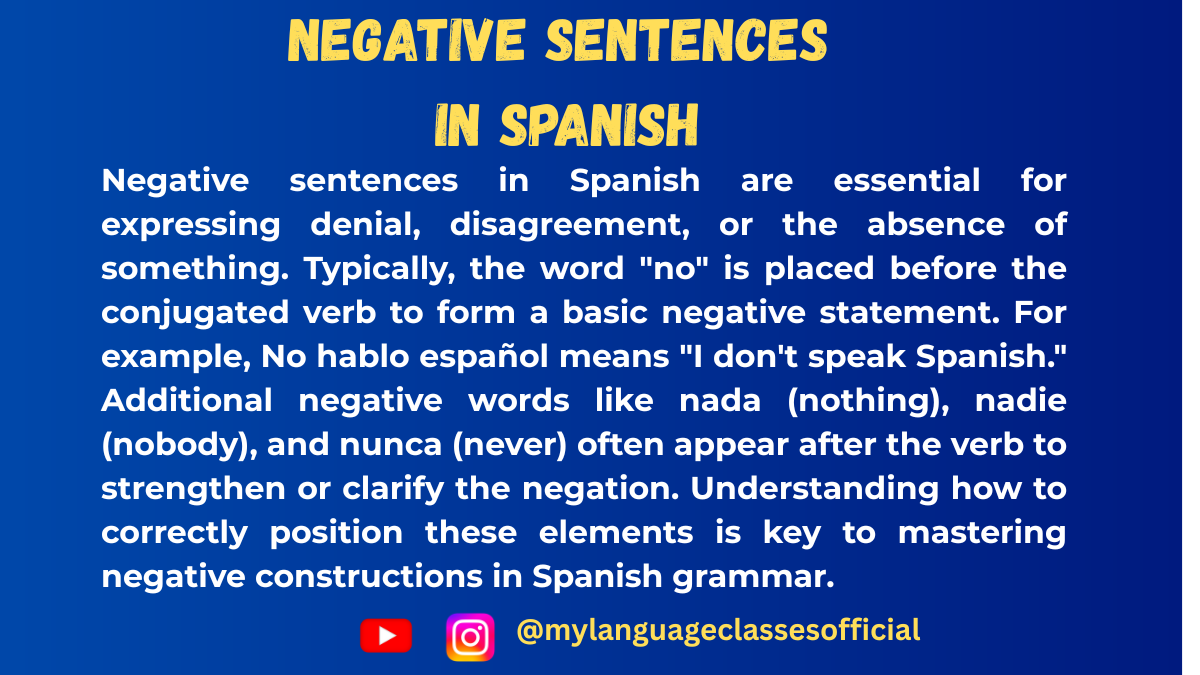
Negative Sentences in Spanish
When learning Spanish, mastering negative sentences is essential for effective communication. Negative sentences allow you to deny, contradict, or express the absence of something. This blog post will guide you through the rules, structures, and common considerations when constructing negative sentences in Spanish, including gender, articles, and plurals.
Basic Structure of Negative Sentences
In Spanish, the word “no” is the key to forming negative sentences. It is placed before the verb.
Examples:
- Affirmative: María canta bien. (María sings well.)
- Negative: María no canta bien. (María does not sing well.)
The structure is straightforward:
Subject + “no” + verb + complement.
Using Negative Words
In Spanish, additional negative words reinforce or replace “no.” These include:
- nada (nothing)
- nadie (nobody)
- ningún/ninguno/ninguna (none, no one)
- nunca (never)
- tampoco (neither)
Double Negatives
Unlike English, double negatives are not only acceptable but required in Spanish. For instance:
- No veo nada. (I don’t see anything.)
- No conozco a nadie. (I don’t know anyone.)
- No estudio nunca. (I never study.)
Here, “no” works in harmony with other negative words.
Gender and Plural Considerations
1. Gender Agreement
Negative words like ninguno and ninguna must agree with the gender of the noun they modify.
- Masculine singular:
No tengo ningún problema. (I don’t have any problem.) - Feminine singular:
No tengo ninguna idea. (I don’t have any idea.)
2. Plural Agreement
In most cases, ninguno is not pluralized, except in specific cases like inherently plural nouns:
- No tengo ningunas vacaciones este año. (I don’t have any vacations this year.)
Position of Negative Words
1. Before the Verb
Negative words like “no” are typically placed before the verb:
- No quiero comer. (I don’t want to eat.)
2. After the Verb
Other negative words may follow the verb for emphasis:
- No quiero nada. (I don’t want anything.)
If a subject pronoun is omitted (common in Spanish), pay attention to word order:
- Nadie sabe la respuesta. (Nobody knows the answer.)
Common Mistakes to Avoid
- Forgetting Double Negatives
Avoid translating English structures directly. Saying No sé algo instead of No sé nada is incorrect. - Ignoring Gender and Number Agreement
Ensure that words like ninguno/ninguna match the noun’s gender and number. - Mixing Articles Incorrectly
When using negative words, omit definite articles unless emphasizing specificity:
- Incorrect: No tengo la idea.
- Correct: No tengo idea.
Practical Tips
- Practice with Examples
Write affirmative and negative versions of sentences:
- Ella siempre llega a tiempo. (She always arrives on time.)
- Ella nunca llega a tiempo. (She never arrives on time.)
- Use Context to Choose Negative Words
- Use nada for “nothing” or “anything.”
- Use nadie when referring to “nobody” or “anybody.”
- Practice Conversations
Create scenarios to apply double negatives naturally:
- No tengo nada que decir. (I have nothing to say.)
Mastering negative sentences in Spanish opens up new possibilities for nuanced communication. Practice regularly, pay attention to gender and number agreement, and soon, negatives will become second nature.
¡Buena suerte! (Good luck!)
If you enjoyed this lesson, be sure to check out more posts like this on my blog at My Language Classes. Don’t forget to subscribe my YouTube channel and follow me on Instagram for the latest language learning tips and lessons. Leave a comment below to share your thoughts, or ask any questions you have.
Happy learning! 😊
-
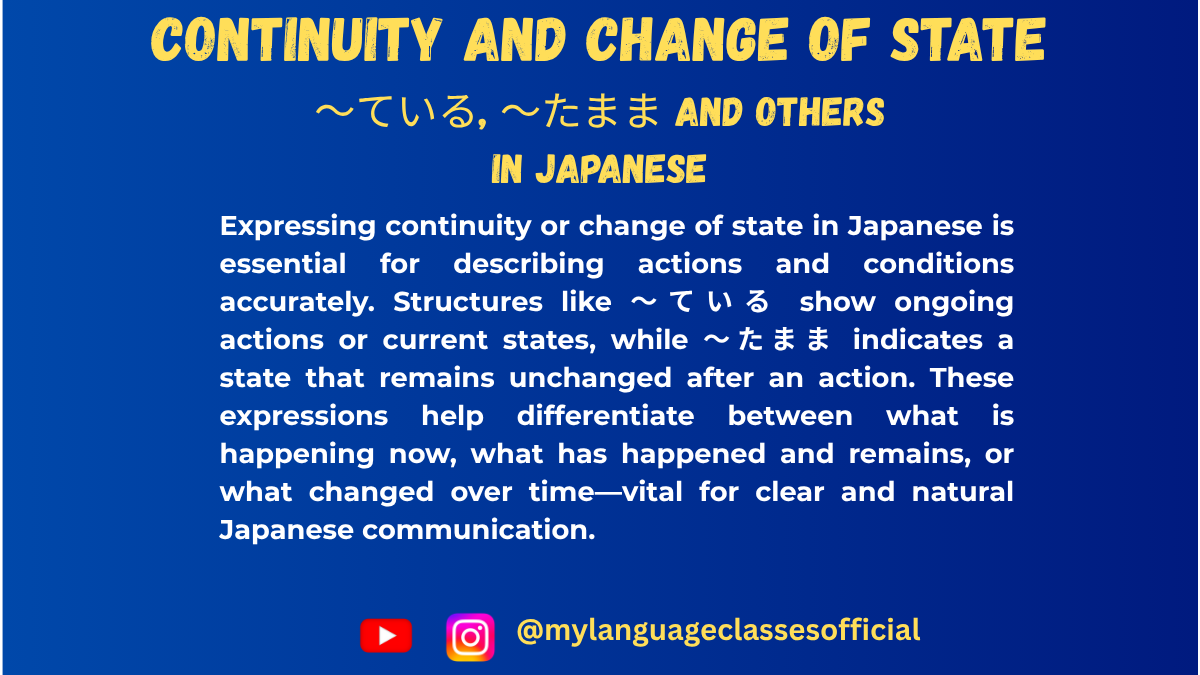
How to Show Continuity in Japanese | My Language Classes
Expressing Continuity or Change of State in Japanese
In Japanese, understanding how to express ongoing actions, states, or transitions is essential for achieving fluency. These expressions allow speakers to describe actions in progress, habitual actions, or states resulting from actions. In this blog, we’ll dive into various patterns to express continuity or a change of state, starting with the well-known Verb て-form + いる, and expanding into other structures and nuances.
1. Verb て-form + いる (~ている)
Usage:
- Continuous Action: Indicates an action currently in progress.
- Example:
- 本を読んでいる。
(Hon o yonde iru.)
“I am reading a book.”
- 本を読んでいる。
- Example:
- Resultant State: Refers to the state resulting from an action.
- Example:
- ドアが開いている。
(Doa ga aite iru.)
“The door is open.” (The action of opening has occurred, and the state is ongoing.)
- ドアが開いている。
- Example:
- Habitual Action: Expresses something done regularly or habitually.
- Example:
- 毎朝ジョギングをしている。
(Maiasa jogingu o shite iru.)
“I jog every morning.”
- 毎朝ジョギングをしている。
- Example:
Points to Keep in Mind:
- The context determines whether it refers to an ongoing action, a resultant state, or a habitual action.
- In casual speech, いる is often contracted to る or omitted entirely. For example:
- 読んでる instead of 読んでいる.
2. Verb Stem + 続ける (~つづける)
This pattern expresses the idea of continuing an action without stopping.
Usage:
- Continuous Action: Indicates persistence or continuity of an action.
- Example:
- 彼は勉強し続ける。
(Kare wa benkyou shi tsuzukeru.)
“He continues to study.”
- 彼は勉強し続ける。
- Example:
Points to Keep in Mind:
- The verb 続ける (to continue) can also be conjugated, e.g., 続けます (formal), 続けた (past tense).
- This structure emphasizes effort or intention behind continuity.
3. Verb た-form + まま
This structure expresses the idea of a state being left unchanged.
Usage:
- Unchanged State: Indicates that something remains in its current state.
- Example:
- 靴を履いたまま部屋に入らないでください。
(Kutsu o haita mama heya ni hairanaide kudasai.)
“Please don’t enter the room with your shoes on.”
- 靴を履いたまま部屋に入らないでください。
- Example:
Points to Keep in Mind:
- The subject must remain in the state expressed by the verb.
- Often used to highlight an undesirable or unintended state.
4. Noun + のまま
Similar to the verb usage, this pattern expresses an unchanged state with nouns.
Usage:
- Unchanged State: Describes a situation where something stays the same.
- Example:
- 冷たい飲み物のまま飲んだ。
(Tsumetai nomimono no mama nonda.)
“I drank it while it was still cold.”
- 冷たい飲み物のまま飲んだ。
- Example:
5. Verb Base + ながら
The ~ながら form allows for the expression of two simultaneous actions.
Usage:
- Simultaneous Actions: Describes doing one action while performing another.
- Example:
- 音楽を聴きながら勉強する。
(Ongaku o kikinagara benkyou suru.)
“I study while listening to music.”
- 音楽を聴きながら勉強する。
- Example:
Points to Keep in Mind:
- The main focus is usually on the action described by the main clause.
- Both actions must involve the same subject.
6. Adjective + まま
Describes a state where something remains as it is, often with adjectives.
Usage:
- Unchanged Condition:
- Example:
- 暑いままで寝てしまった。
(Atsui mama de nete shimatta.)
“I fell asleep while it was still hot.”
- 暑いままで寝てしまった。
- Example:
7. Verb て-form + いく / Verb て-form + くる
These forms express a change of state over time or movement.
Usage:
- ~ていく: Indicates a progression away from the present or current state.
- Example:
- 暗くなっていく。
(Kuraku natte iku.)
“It’s getting darker.”
- 暗くなっていく。
- Example:
- ~てくる: Indicates a progression towards the present or a return to the current state.
- Example:
- 涼しくなってきた。
(Suzushiku natte kita.)
“It has started to become cool.”
- 涼しくなってきた。
- Example:
Points to Keep in Mind:
- These forms are particularly useful for describing gradual or dynamic changes.
8. Verb Stem + 出す / Verb Stem + 始める
Both patterns describe the initiation of an action or state.
Usage:
- ~出す: Indicates a sudden or spontaneous beginning of an action.
- Example:
- 赤ちゃんが泣き出した。
(Akachan ga nakidashita.)
“The baby started crying.”
- 赤ちゃんが泣き出した。
- Example:
- ~始める: Describes the commencement of an action.
- Example:
- 本を読み始める。
(Hon o yomihajimeru.)
“I start reading a book.”
- 本を読み始める。
- Example:
Points to Keep in Mind:
- 出す suggests a more abrupt or unexpected start, while 始める implies a deliberate beginning.
Final Thoughts:
When discussing continuity or a change of state in Japanese, understanding the nuances of these patterns is crucial. The choice of expression depends on context, intent, and the subtleties of the situation being described. Here are some key points to remember:
- Context is king: Be mindful of whether you’re describing an ongoing action, a habitual action, or a resultant state.
- Nuance matters: Patterns like ~ていく and ~てくる convey subtle differences in directionality or emotional tone.
- Practice in context: Try creating sentences using each pattern to internalize their meanings and usage.
By mastering these structures, you can convey complex temporal and state-related concepts in Japanese with clarity and precision. Happy learning! 😊
If you enjoyed this lesson, be sure to check out more posts like this on my blog at My Language Classes. Don’t forget to subscribe my YouTube channel and follow me on Instagram for the latest language learning tips and lessons. Leave a comment below to share your thoughts, or ask any questions you have about nouns.
Happy learning! 😊
- Continuous Action: Indicates an action currently in progress.
-
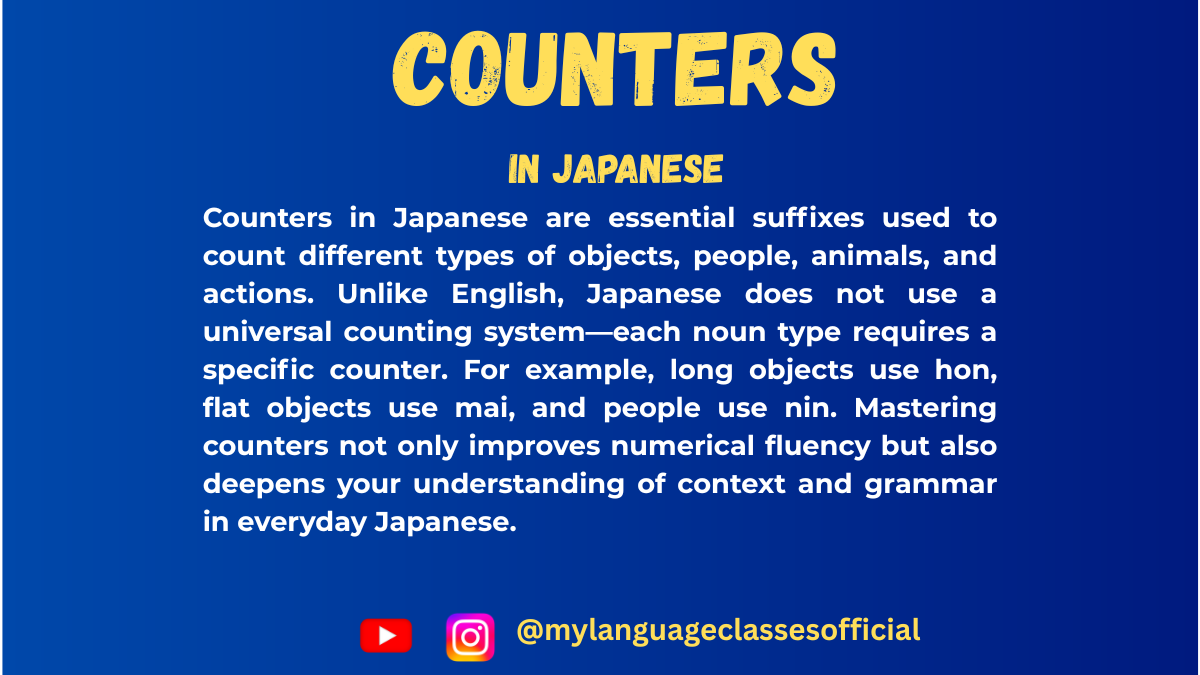
Mastering Japanese Counters | My Language Classes
Mastering Japanese Counters
When learning Japanese, one unique and challenging aspect for learners is the use of counters. Unlike English, Japanese uses specific words when counting objects, animals, people, and even abstract concepts. These counters change depending on the type and shape of the item being counted. In this post, we’ll delve deep into the world of Japanese counters, explain the logic behind them, and provide tips to use them confidently in everyday conversation.
What Are Counters in Japanese?
Counters are suffixes used to indicate the type or category of the item being counted. For example:
- 本 (ほん) is used for long, cylindrical objects like bottles or pencils.
- 枚 (まい) is for thin, flat objects like paper or plates.
- 匹 (ひき) is for animals like cats or fish.
To count items, you combine a number with the appropriate counter, often modifying the pronunciation depending on the number.
Basic Structure
The typical structure is:
Number + Counter
Examples:
- 一本 (いっぽん) — one pen (using the counter for long objects)
- 三枚 (さんまい) — three sheets of paper (using the counter for flat objects)
- 五匹 (ごひき) — five dogs (using the counter for animals)
However, it’s important to know irregular pronunciations, which often occur with numbers like 1, 3, 6, and 8. We’ll discuss this in detail below.
Common Counters and Their Usage
Here are some of the most frequently used counters:
1. General Items: 個 (こ)
Used for small, generic objects.
- Examples: 一個 (いっこ) — one piece, 三個 (さんこ) — three pieces.
2. Long Objects: 本 (ほん)
Used for items like pens, bottles, trees, and trains.
- Irregular pronunciations:
- 1本 (いっぽん)
- 3本 (さんぼん)
- 6本 (ろっぽん)
3. Flat Objects: 枚 (まい)
Used for items like paper, plates, and T-shirts.
- Examples: 一枚 (いちまい) — one sheet, 十枚 (じゅうまい) — ten sheets.
4. People: 人 (にん)
Used for counting people, with some exceptions:
- 1 person: 一人 (ひとり)
- 2 people: 二人 (ふたり)
- 3 or more: Regular pattern (三人 [さんにん], etc.).
5. Animals: 匹 (ひき)
Used for small animals like cats, dogs, and fish.
- Irregular pronunciations:
- 1匹 (いっぴき)
- 3匹 (さんびき)
- 6匹 (ろっぴき)
6. Books and Magazines: 冊 (さつ)
Used for bound objects like books and notebooks.
- Irregular pronunciations:
- 1冊 (いっさつ)
- 8冊 (はっさつ)
7. Machines and Vehicles: 台 (だい)
Used for cars, TVs, and other machinery.
- Examples: 一台 (いちだい), 五台 (ごだい).
8. Large Animals: 頭 (とう)
Used for cows, horses, and elephants.
- Examples: 一頭 (いっとう), 三頭 (さんとう).
Tips to Master Counters
- Start with Common Counters: Focus on frequently used counters like 個, 本, and 枚 before delving into specialized ones.
- Memorize Irregular Forms: Pay attention to irregular readings for numbers like 1, 3, 6, and 8.
- Practice with Real-Life Examples: Use counters in context, like ordering food or describing objects around you. For instance:
- レストランで: コーヒーを二杯 (にはい)ください (At a restaurant: “Two cups of coffee, please.”).
- Watch Native Speakers: Listen to native speakers to understand how counters are naturally used in conversation.
Things to Keep in Mind
- Context Matters: The appropriate counter often depends on the item’s size, shape, or category.
- Colloquial Shortcuts: In casual conversation, native speakers may drop the counter altogether if the context is clear:
- Example: りんご三つ (みっつ) instead of 三個.
- Counters for Abstract Concepts: Words like 回 (かい) for times or 度 (ど) for occurrences can be tricky. Practice distinguishing them:
- 一回 (いっかい) — once
- 一度 (いちど) — one time (but often implies a more formal or singular occasion).
Learning Through Examples
Here are some sample sentences to see counters in action:
- Books and Magazines:
- 本を三冊買いました。
(ほんをさんさつかいました)
I bought three books.
- 本を三冊買いました。
- Animals:
- 犬が五匹います。
(いぬがごひきいます)
There are five dogs.
- 犬が五匹います。
- Drinks:
- ビールを二杯ください。
(びーるをにはいください)
Two beers, please.
- ビールを二杯ください。
- People:
- 学生が十人来ました。
(がくせいがじゅうにんきました)
Ten students came.
- 学生が十人来ました。
Practice Makes Perfect
To truly master Japanese counters, practice is essential. Start by identifying objects around you and attaching the appropriate counter. Here’s a challenge for you:
- Look around your room and count:
- Books (冊)
- Pens (本)
- Chairs (台)
- Photos (枚).
By incorporating counters into daily life, you’ll quickly become more comfortable and natural when speaking Japanese.
Final Thoughts
Japanese counters can feel overwhelming at first, but they also add precision and beauty to the language. By focusing on common counters, practicing regularly, and immersing yourself in authentic Japanese content, you’ll be able to master this unique aspect of Japanese in no time. Keep practicing, and don’t be afraid to make mistakes—they’re the stepping stones to fluency. 頑張ってね!(Good luck!)
If you enjoyed this lesson, be sure to check out more posts like this on my blog at My Language Classes. Don’t forget to subscribe my YouTube channel and follow me on Instagram for the latest language learning tips and lessons. Leave a comment below to share your thoughts, or ask any questions you have about nouns.
Happy learning! 😊
-
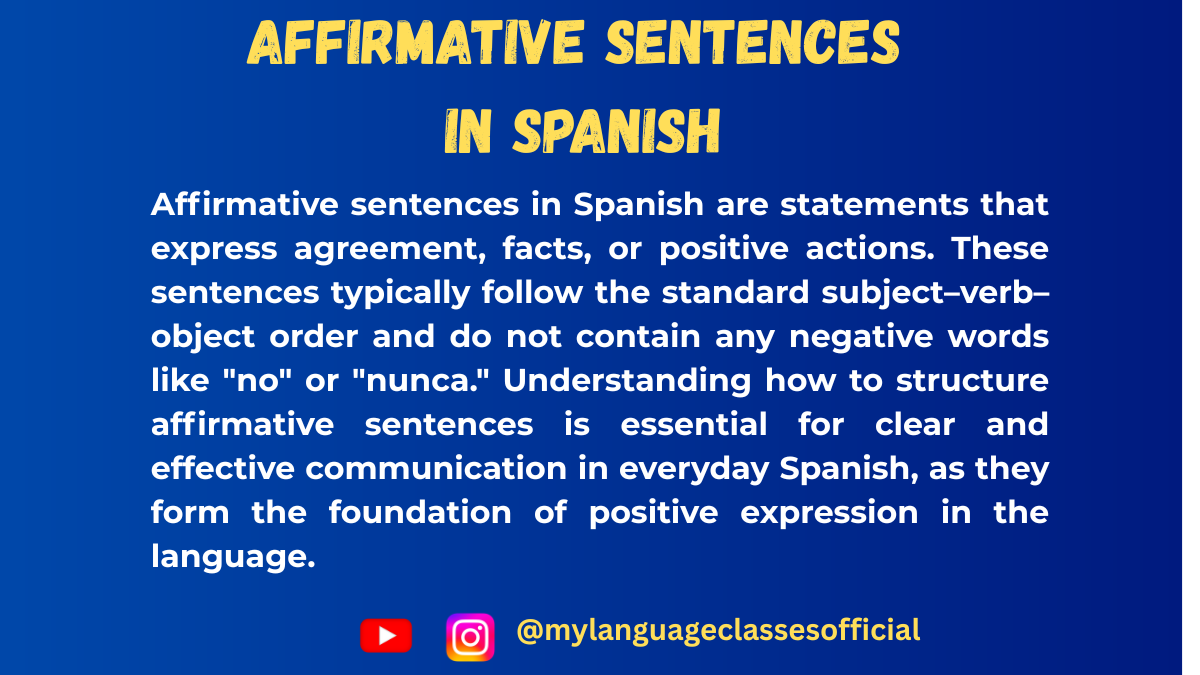
Affirmative Sentences in Spanish
Affirmative sentences in Spanish are the backbone of everyday communication. They help you convey basic facts, express opinions, and share information. In this blog post, we’ll break down the structure of affirmative sentences, explore key grammar rules, and cover essential points related to gender, pluralization, and the use of articles.
What Are Affirmative Sentences?
Affirmative sentences are straightforward statements that assert or affirm something. For example:
- Yo tengo un perro. (I have a dog.)
- Ellos están felices. (They are happy.)
These sentences contrast with negative sentences (No tengo un perro) and questions (¿Tienes un perro?).
Basic Structure of Affirmative Sentences
In Spanish, the standard sentence structure follows this order:
Subject + Verb + ComplementExamples:
- Ella canta una canción. (She sings a song.)
- Nosotros leemos libros en la biblioteca. (We read books in the library.)
Although Spanish word order can sometimes be flexible for stylistic reasons, this is the default format.
Key Grammar Points for Affirmative Sentences
1. Gender and Number Agreement
In Spanish, nouns and adjectives must agree in gender (masculine/feminine) and number (singular/plural).
- Masculine nouns often end in -o (e.g., niño – boy) and feminine nouns in -a (e.g., niña – girl).
- Adjectives also change based on gender and number.
- Singular: El perro negro (The black dog).
- Plural: Los perros negros (The black dogs).
2. Use of Definite and Indefinite Articles
Articles are essential in Spanish affirmative sentences.
- Definite Articles (the):
- Singular: el (masculine), la (feminine)
- Plural: los (masculine), las (feminine)
Example: El libro está en la mesa. (The book is on the table.)
- Indefinite Articles (a, an, some):
- Singular: un (masculine), una (feminine)
- Plural: unos (masculine), unas (feminine)
Example: Tengo una idea. (I have an idea.)
3. Regular vs. Irregular Verbs
Verbs in Spanish can be regular or irregular. Pay attention to conjugation based on the subject.
- Regular verb example:
Yo hablo español. (I speak Spanish.) - Irregular verb example:
Ella tiene un hermano. (She has a brother.)
4. Pronoun Usage
In Spanish, subject pronouns (yo, tú, él/ella, nosotros, vosotros, ellos/ellas) are often optional. The verb conjugation usually makes the subject clear.
- Yo como manzanas. = Como manzanas. (I eat apples.)
Examples of Affirmative Sentences in Context
Here’s how affirmative sentences work with different grammatical rules:
- Singular and Plural
- Singular: El niño juega en el parque. (The boy plays in the park.)
- Plural: Los niños juegan en el parque. (The boys play in the park.)
- Gender Agreement
- Masculine: Un profesor simpático enseña la clase. (A nice professor teaches the class.)
- Feminine: Una profesora simpática enseña la clase. (A nice female professor teaches the class.)
- Verb Conjugations
- Regular: Nosotros aprendemos español. (We learn Spanish.)
- Irregular: Yo voy al supermercado. (I go to the supermarket.)
- Complex Sentences
- Ellos están comiendo en el restaurante italiano. (They are eating at the Italian restaurant.)
Tips for Forming Affirmative Sentences
- Practice Verb Conjugations: Learn the present tense conjugation of regular verbs (-ar, -er, -ir) and memorize irregular ones.
- Master Articles and Agreement: Always match articles and adjectives with the gender and number of the noun.
- Expand Vocabulary: Build your vocabulary with common nouns, adjectives, and verbs to create diverse sentences.
- Practice Speaking: Use affirmative sentences in daily conversations to build fluency.
Common Mistakes to Avoid
- Skipping Gender and Number Agreement:
- Incorrect: La casa blancos.
- Correct: La casa blanca.
- Incorrect Article Usage:
- Incorrect: Un agua fría.
- Correct: Una agua fría. (Water is feminine, even though it begins with a stressed “a.”)
- Overusing Pronouns:
- Not necessary: Yo voy al cine.
- Better: Voy al cine.
Practice Exercises
- Convert these phrases to plural:
- El gato está en la casa.
- Una flor roja decora la mesa.
- Match the adjective to the noun:
- El coche (rojo/roja).
- Las niñas (inteligentes/inteligente).
- Conjugate the verb:
- Nosotros (hablar) español.
- Ella (comer) una manzana.
Conclusion
Understanding affirmative sentences is crucial for building confidence in Spanish. By mastering the rules of sentence structure, verb conjugations, and gender and number agreement, you’ll be well on your way to expressing yourself clearly and fluently.
Practice regularly, and don’t hesitate to immerse yourself in conversations or writing exercises. ¡Buena suerte! (Good luck!)
If you enjoyed this lesson, be sure to check out more posts like this on my blog at My Language Classes. Don’t forget to subscribe my YouTube channel and follow me on Instagram for the latest language learning tips and lessons. Leave a comment below to share your thoughts, or ask any questions you have.
Happy learning! 😊
-
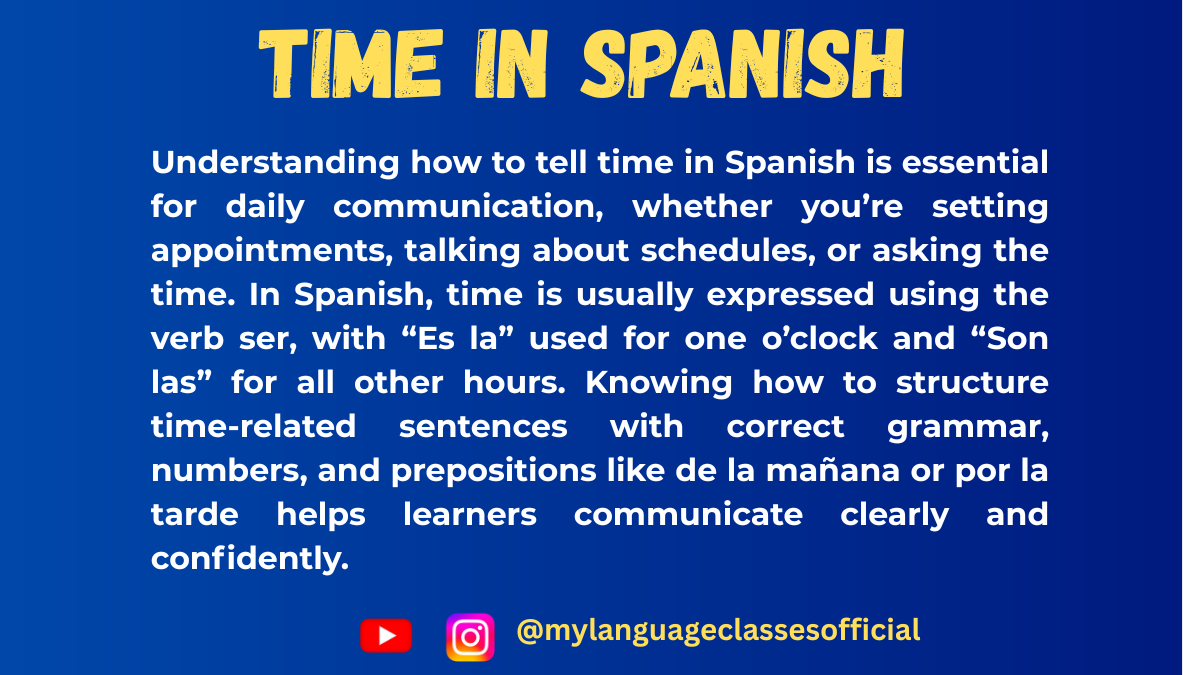
How to Ask and Tell Time in Spanish
Learning how to ask and tell the time in Spanish is one of the most practical and essential skills for Spanish learners. Not only will it help you in everyday conversations, but it also introduces you to key grammar concepts like articles, singular/plural forms, and verb usage.
In this blog post, we’ll break everything down step-by-step, so you can confidently talk about time like a native speaker.
1. Asking for the Time in Spanish
If you want to know what time it is, the most common way to ask is:
- ¿Qué hora es? (What time is it?)
This phrase is simple and polite, and it works in any situation.
If you want to ask someone more directly, you can say:- ¿Me puedes decir la hora, por favor? (Can you tell me the time, please?)
- ¿Tiene(s) la hora? (Do you have the time?)
💡 Note: Use tiene in formal settings and tienes with friends or peers.
2. Telling the Time in Spanish
Now that you’ve been asked the time, here’s how you respond:
Basic Structure
To tell the time in Spanish, you start with:
- Es la… → for 1 o’clock (singular hour).
- Son las… → for all other hours (plural).
For example:
- Es la una. → It’s 1:00.
- Son las dos. → It’s 2:00.
Adding Minutes
When adding minutes, use the following words:
- y → for “and” (used for minutes up to 30).
- menos → for subtracting minutes (used after 30 minutes).
Examples:
- It’s 3:15 → Son las tres y quince / Son las tres y cuarto (a quarter past three).
- It’s 4:30 → Son las cuatro y treinta / Son las cuatro y media (half past four).
- It’s 5:45 → Son las seis menos cuarto (a quarter to six).
On the Dot (Exact Time)
To say the time is exactly on the hour, add:
- en punto → “on the dot”
Example:
- Son las siete en punto. → It’s exactly 7:00.
3. Talking About AM and PM in Spanish
Spanish does not have a direct equivalent to AM and PM. Instead, time is expressed using specific phrases to indicate morning, afternoon, or evening:
- de la mañana → in the morning (AM)
- de la tarde → in the afternoon (PM, until evening)
- de la noche → at night (PM, after evening)
Examples:
- Es la una de la mañana. → It’s 1:00 in the morning.
- Son las tres de la tarde. → It’s 3:00 in the afternoon.
- Son las nueve de la noche. → It’s 9:00 at night.
Pro Tip: If you are speaking generally without specifying AM/PM, you can say por la mañana, por la tarde, or por la noche.
4. Key Grammar Rules for Telling Time
Definite Articles (La and Las)
In Spanish, time is feminine because it refers to the phrase “la hora” (the hour). This is why we use la (singular) and las (plural) with time.
- Es la una. → La for singular (1:00).
- Son las cinco. → Las for plural hours (2 and beyond).
Singular and Plural Usage
- Use es (is) with 1:00, as it refers to a single hour.
- Use son (are) with all other times, as they involve multiple hours.
Examples:
- Es la una. → It’s 1:00.
- Son las dos. → It’s 2:00.
5. Military Time (24-Hour Clock)
Spanish-speaking countries often use the 24-hour clock, especially for schedules like train or bus timetables.
- 14:00 → Son las dos de la tarde. (2:00 PM)
- 20:30 → Son las ocho y media de la noche. (8:30 PM)
If you’re not used to it, just subtract 12 from any hour after 12:00.
6. Common Expressions and Phrases
To sound more natural when talking about time, here are some useful phrases:
- ¿A qué hora…? → At what time…?
- Example: ¿A qué hora es la reunión? → What time is the meeting?
- La clase es a las cinco. → The class is at 5:00.
- Llegamos tarde. → We’re late.
- Es temprano. → It’s early.
7. Practice Makes Perfect
Here’s a quick exercise for you! Try to answer the following questions:
- ¿Qué hora es? (It’s 1:15.)
- ¿A qué hora comes? (Answer: I eat at 12:30 PM.)
- ¿Qué hora es? (It’s 7:45 PM.)
Answers:
- Es la una y cuarto.
- Como a las doce y media de la tarde.
- Son las ocho menos cuarto de la noche.
Conclusion
Understanding how to ask and tell time in Spanish involves learning basic structures, articles, and the singular/plural distinction. By practicing these rules and incorporating common phrases into your conversations, you’ll sound like a native speaker in no time.
Now, ¿qué hora es?—start practicing with your friends and daily routines!
Did you find this blog post helpful? Let me know in the comments below, and share it with someone learning Spanish! 👇
If you enjoyed this lesson, be sure to check out more posts like this on my blog at My Language Classes. Don’t forget to subscribe my YouTube channel and follow me on Instagram for the latest language learning tips and lessons. Leave a comment below to share your thoughts, or ask any questions you have.
Happy learning! 😊
-
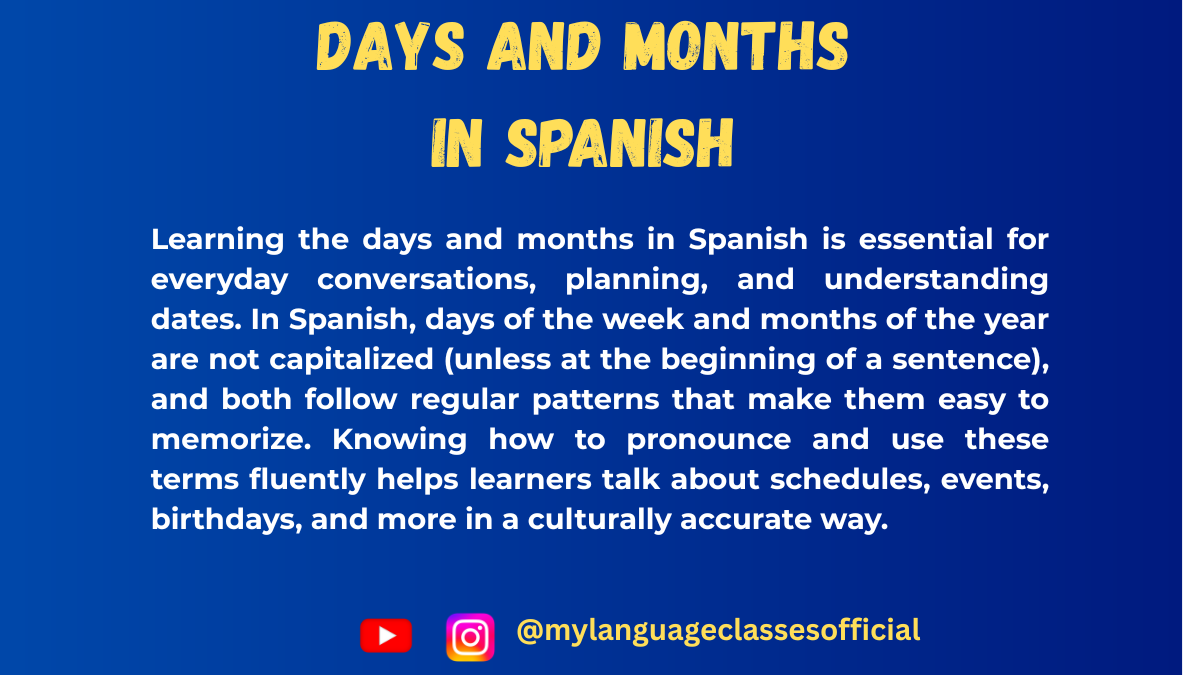
Days and Months in Spanish
Learning the days of the week and months of the year in Spanish is an essential step for beginners. Not only are these words commonly used in daily conversations, but they also form the foundation for understanding dates, planning schedules, and discussing time.
Days of the Week (Los días de la semana)
Here are the days of the week in Spanish:
Spanish English Pronunciation lunes Monday LOO-nes martes Tuesday MAR-tes miércoles Wednesday mee-ÉR-co-les jueves Thursday HWE-ves viernes Friday VYER-nes sábado Saturday SÁ-ba-do domingo Sunday do-MEEN-go Key Points to Remember:
- Articles with Days of the Week:
- Days of the week in Spanish are typically preceded by the definite article el (singular) or los (plural).
Example:- El lunes voy al mercado. (On Monday, I’m going to the market.)
- Los sábados descanso. (On Saturdays, I rest.)
- When discussing habitual actions, the article is required. However, articles are omitted if you refer to a specific instance or use the verb ser (to be).
Example:- Hoy es miércoles. (Today is Wednesday.)
- Days of the week in Spanish are typically preceded by the definite article el (singular) or los (plural).
- Pluralization:
- Most days of the week have the same form for both singular and plural (e.g., el lunes → los lunes).
- Exceptions: sábado and domingo add an -s to become plural: los sábados, los domingos.
- Capitalization:
- Days of the week are not capitalized in Spanish unless they are at the beginning of a sentence.
Months of the Year (Los meses del año)
Here are the months of the year in Spanish:
Spanish English Pronunciation enero January eh-NE-ro febrero February fe-BRE-ro marzo March MAR-tho abril April ah-BREEL mayo May MA-yo junio June HOO-nyo julio July HOO-lyo agosto August ah-GOS-to septiembre September sep-TYEHM-bre octubre October oc-TOO-bre noviembre November no-VYEHM-bre diciembre December dee-TYEHM-bre Key Points to Remember:
- Articles with Months:
- Unlike days of the week, months are not usually used with articles unless they are part of a specific context.
Example:- Nací en abril. (I was born in April.)
- El marzo pasado fue lluvioso. (Last March was rainy.)
- Unlike days of the week, months are not usually used with articles unless they are part of a specific context.
- Prepositions:
- The preposition en is used to indicate a month.
Example:- Vamos de vacaciones en agosto. (We’re going on vacation in August.)
- The preposition en is used to indicate a month.
- Capitalization:
- Like the days of the week, months are also not capitalized in Spanish unless at the start of a sentence.
Cultural Notes
- Starting the Week:
- In Spanish-speaking countries, the week traditionally starts on lunes (Monday), unlike in English, where it often starts on Sunday.
- Abbreviations:
- Days of the week are commonly abbreviated in informal writing:
- L, M, X, J, V, S, D
(X is used for miércoles to avoid confusion with martes.)
- L, M, X, J, V, S, D
- Months can also be abbreviated, especially in calendars: ene., feb., mar., etc.
- Days of the week are commonly abbreviated in informal writing:
- Expressions and Idioms:
- Día de descanso: Day off (typically Sunday in many cultures).
- Fines de semana: Weekends (Saturday and Sunday).
- Un día cualquiera: Any given day.
Practical Tips for Learners
- Practice with Real-Life Scenarios:
- Try saying today’s date in Spanish:
- Hoy es lunes, 16 de diciembre de 2024.
- Practice asking and answering questions:
- ¿Qué día es hoy? (What day is today?)
- Hoy es martes. (Today is Tuesday.)
- Try saying today’s date in Spanish:
- Use Mnemonics:
- Associate each Spanish word with something familiar in your language. For example:
- lunes sounds like “lunar” (Monday named after the Moon).
- sábado sounds like “Sabbath.”
- Associate each Spanish word with something familiar in your language. For example:
- Flashcards and Apps:
- Use tools like flashcards, apps, or sticky notes to memorize days and months.
- Immersion:
- Incorporate Spanish calendars, write your plans in Spanish, and read Spanish articles to see these words in context.
By mastering these basics, you’ll gain confidence to engage in Spanish conversations about schedules, holidays, and seasons. ¡Buena suerte! (Good luck!)
If you enjoyed this lesson, be sure to check out more posts like this on my blog at My Language Classes. Don’t forget to subscribe my YouTube channel and follow me on Instagram for the latest language learning tips and lessons. Leave a comment below to share your thoughts, or ask any questions you have.
Happy learning! 😊
- Articles with Days of the Week:
